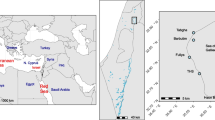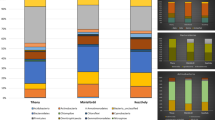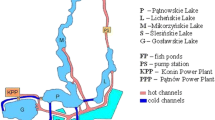Abstract
Legionella species are ubiquitous bacteria in aquatic environments. To examine the effect of anthropogenic impacts and physicochemical characteristics on the Legionellaceae population, we collected water from two sites in the Itanhaém River system in the Atlantic Forest of Brazil. One sample was collected from an upstream pristine region, the other from a downstream estuarine region moderately affected by untreated domestic sewage. Cultures on a selective medium failed to isolate Legionella species. Culture-independent methods showed that water from the estuarine aquatic habitat contained DNA sequences homologous to the 16S ribosomal DNA gene of Legionella pneumophila and non-pneumophila species. In pristine water, only two sequences related to L. pneumophila were detected. The results suggest that salinity and anthropogenic factors, such as wastewater discharge, favor a diversity of Legionella species, whereas pristine freshwater selects for Legionella pneumophila.

Similar content being viewed by others
Literature Cited
Abu Kwaik Y, Gao LY, Stone BJ, et al. (1998) Invasion of protozoan by Legionella pneumophila and its role in bacterial ecology and pathogenesis. Appl Environ Microbiol 64:3127–3133
Ahn SC, Baek BS, Oh T, et al. (2000) Rapid mini-scale plasmid isolation for DNA sequencing and restriction mapping. Biotechniques 29:466–468
Altschul SF, Madden TL, Schäffer AA, et al. (1997) Gapped BLAST and PSI-BLAST: A new generation of protein database search programs. Nucleic Acids Res 25:3389–3402
Ashelford KE, Chuzhanova NA, Fry JC, et al. (2005) At least 1 in 20 16S rRNA sequences records currently held in public repositories is estimated to contain substantial anomalies. Appl Environ Microbiol 71:7724–7736
Berendt RF (1980) Influence of blue-green algae (cyanobacteria) on survival of Legionella pneumophila in aerosols. Infect Immun 32:690–692
Bopp CA, Sumner JW, Morris GK, Wells JG (1981) Isolation of Legionella spp. from environmental water samples by low-pH treatment and use of a selective medium. J Clin Microbiol 13:714–719
Calvo-Bado LA, Morgan JA, Sergeant M, et al. (2003) Molecular characterization of Legionella populations present within slow sand filters used for fungal plant pathogen suppression in horticultural crops. Appl Environ Microbiol 69:533–541
Camargo AFM, Ferreira RAR, Schiavetti A, Bini LM (1996) Influence of physiographic and human activity on limnological characteristics of lotic ecosystems of the south coast of São Paulo, Brazil. Acta Limnol Bras 8:241–243
Catalan V, Garcia F, Moreno C, et al. (1997) Detection of Legionella pneumophila in wastewater by nested polymerase chain reaction. Res Microbiol 148:71–78
Costa J, Tiago I, Costa MS, Veríssimo A (2005) Presence and persistence of Legionella spp. in groundwater. Appl Environ Microbiol 71:663–671
Fliermans CB, (1984) Philosophical ecology: Legionella in historical perspective. In: Thornsberry C, Balows A, Feeley JC, Jakubowski W (eds) Legionella: Proceedings of the 2nd International Symposium. Washington, DC: American Society for Microbiology, pp 285–289
Fliermans CB, Cherry WB, Orrison LH, et al. (1981) Ecologic distribution of Legionella pneumophila. Appl Environ Microbiol 41:9–16
Garduño RA, Garduño E, Hiltz M, Hoffman PS (2002) Intracellular growth of Legionella pneumophila gives increase to a differentiation form dissimilar to stationary-phase forms. Infect Immun 70:6273–6283
Hall TA (1999) BioEdit: A user-friendly biologic sequence alignment editor and analysis program for Windows 95/98/NT. Nucleic Acids Symp Ser 41:95–98
Helbig JH, Lück PC, Kunz B, Bubert A (2006) Evaluation of the duopath Legionella lateral flow assay for identification of Legionella pneumophila and Legionella species culture isolate. Appl Environ Microbiol 72:4489–4491
Heller R, Höller C, Sübmuth R, Gundermann KO (1998) Effect of salt concentration and temperature on survival of Legionella pneumophila. Lett Appl Microbiol 26:64–68
Horng Y-T, Soo P-C, Shen B-J, et al. (2006) Development of an improved PCR-ICT hybrid assay for direct detection of Legionellae and Legionella pneumophila from cooling tower water specimens. Water Res 40:2221–2229
Hsu SC, Martin R, Wentworth BB (1984) Isolation of Legionella species from drinking water. Appl Environ Microbiol 48:830–832
Kusnetsov JM, Ottoila E, Martikainen PJ (1996) Growth, respiration and survival of Legionella pneumophila at high temperatures. J Appl Bacteriol 81:341–347
Leoni E, De Luca G, Legnani PP, et al. (2005) Legionella waterline colonization: Detection of Legionella species in domestic, hotel and hospital hot water systems. J Appl Microbiol 98:373–379
Maidak BL, Cole JR, Lilburn TG, et al. (2000) The RDP (Ribosomal Data Project) continues. Nucleic Acids Res 28:173–174
Miyamoto H, Yamamoto H, Arima K, et al. (1997) Development of a seminested PCR method for the detection of Legionella species and its application to surveillance of Legionellae in hospital cooling tower water. Appl Environ Microbiol 63:2489–2494
Newsome AL, Scott TM, Benson RF, Fields BS (1998) Isolation of an amoeba naturally harboring a distinctive Legionella species. Appl Environ Microbiol 64:1688–1693
Ortiz-Roque CM, Hazen TC (1987) Abundance and distribution of Legionellaceae in Puerto Rican waters. Appl Environ Microbiol 53:2231–2236
Palmer CJ, Tsai YL, Pazko-Kolva C, et al. (1993) Detection of Legionella species in sewage and ocean water by polymerase chain reaction, direct fluorescent-antibody, and plate culture methods. Appl Environ Microbiol 59:3618–3624
Paszko-Kolva C, Hacker PA, Stewart MA, Wolfe RL (1993) Inhibitory effect of heterotrophic bacteria on the cultivation of Legionella dumoffii In: Barbaree JM, Breiman RF, Dufour AP (eds) Legionella: Proceedings of the 4th International Symposium. Washington, DC: American Society for Microbiology, pp 203–205
Pezzato MM, Camargo AFM (2004) Photosynthetic rate of the aquatic macrophyte Egeria densa Planch. (Hydrocharitaceae) in two rivers from the Itanhaém River Basin in São Paulo State, Brazil. Braz Arch Biol Technol 47:153–162
Posada D, Crandall KA (1998) Modeltest: Testing the model of DNA substitution. Bioinformatics 14:817–818
Sanden GN, Morril WE, Fields BS, et al. (1992) Incubation of water samples improves detection of Legionellae by the culture method. Appl Environ Microbiol 58:2001–2004
Sheehan KB, Henson JM, Ferris MJ (2005) Legionella species diversity in an acidic biofilm community in Yellowstone National Park. Appl Environ Microbiol 71:507–511
Swofford DL (2002) PAUP*: Phylogenetic Analysis Using Parsimony (*and Other Methods), version 4.0b10 for 32-bit Microsoft Windows. Sunderland, MA: Sinauer
Thompson JD, Higgins DG, Gibson TJ (1994) CLUSTAL W: Improving the sensitivity of progressive multiple sequence alignment through sequence weighting, position-specific gap penalties and weight matrix choice. Nucleic Acids Res 22:4673–4680
Tison DL, Pope DH, Cherry WB, Fliermans CB (1980) Growth of Legionella pneumophila in association with blue-green algae (cyanobacteria). Appl Environ Microbiol 39:456–459
Wadowsky RM, Yee RB (1981) Glycine-containing selective medium for isolation of Legionellaceae from environmental specimens. Appl Environ Microbiol 42:768–772
Wullings BA, van der Kooij D (2006) Occurrence and genetic diversity of uncultured Legionella spp. in drinking water treated at temperature below 15°C. Appl Environ Microbiol 72:157–166
Acknowledgments
This study was supported by grant 480753/2004-0 from Conselho Nacional de Desenvolvimento Científico e Tecnológico (CNPq). F.R.S.C. was supported by a doctoral fellowship from Coordenação de Aperfeiçoamento de Pessoal de Nível Superior (CAPES).
Author information
Authors and Affiliations
Corresponding author
Rights and permissions
About this article
Cite this article
Carvalho, F.R., Vazoller, R.F., Foronda, A.S. et al. Phylogenetic Study of Legionella Species in Pristine and Polluted Aquatic Samples from a Tropical Atlantic Forest Ecosystem. Curr Microbiol 55, 288–293 (2007). https://doi.org/10.1007/s00284-006-0589-1
Received:
Accepted:
Published:
Issue Date:
DOI: https://doi.org/10.1007/s00284-006-0589-1




